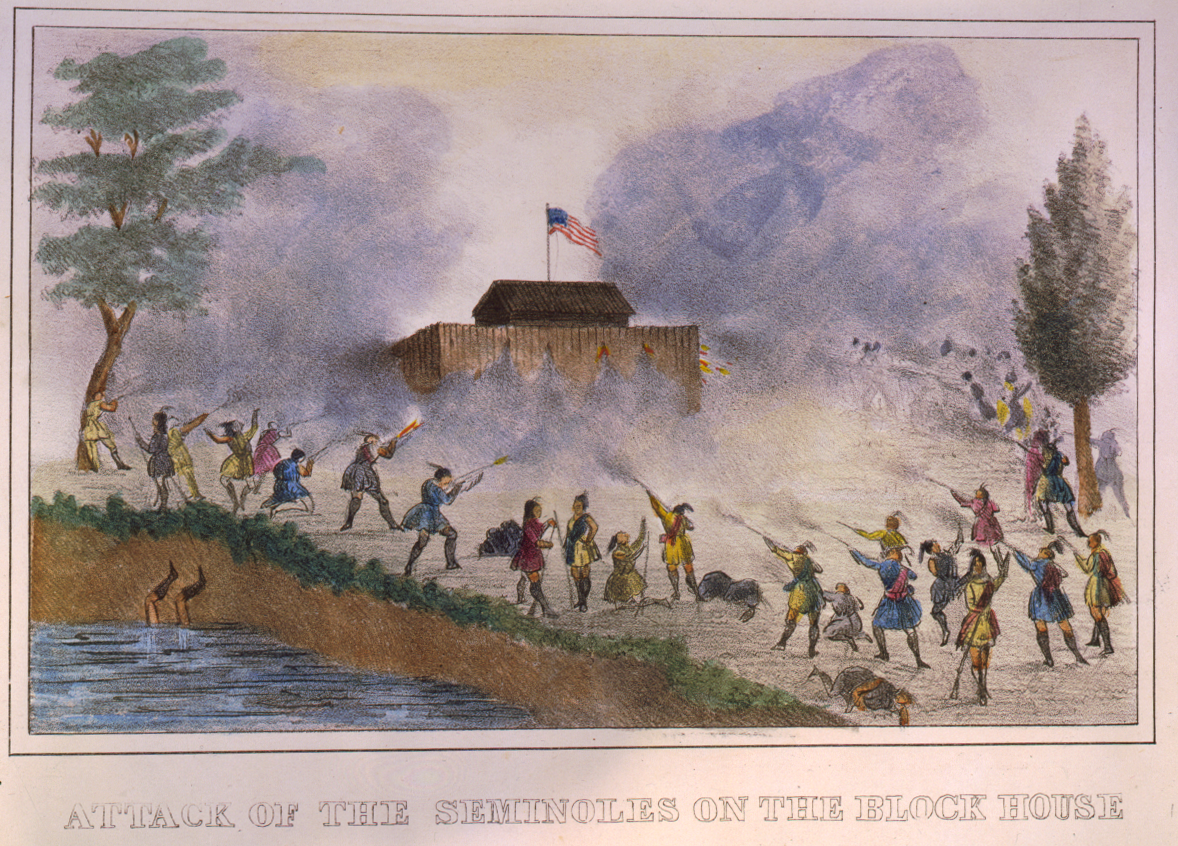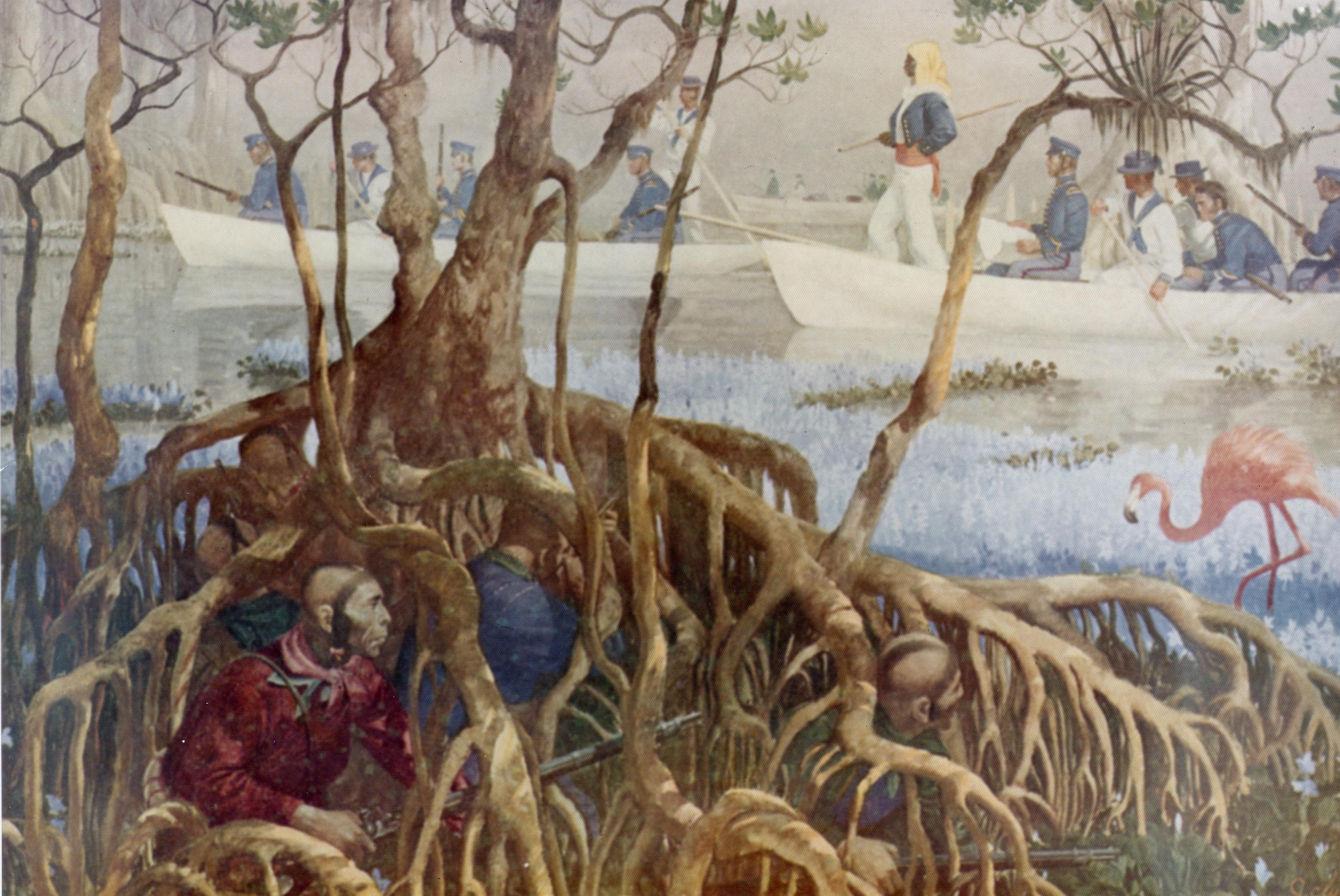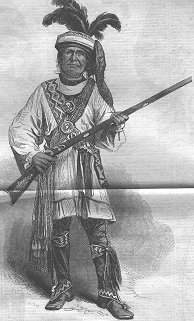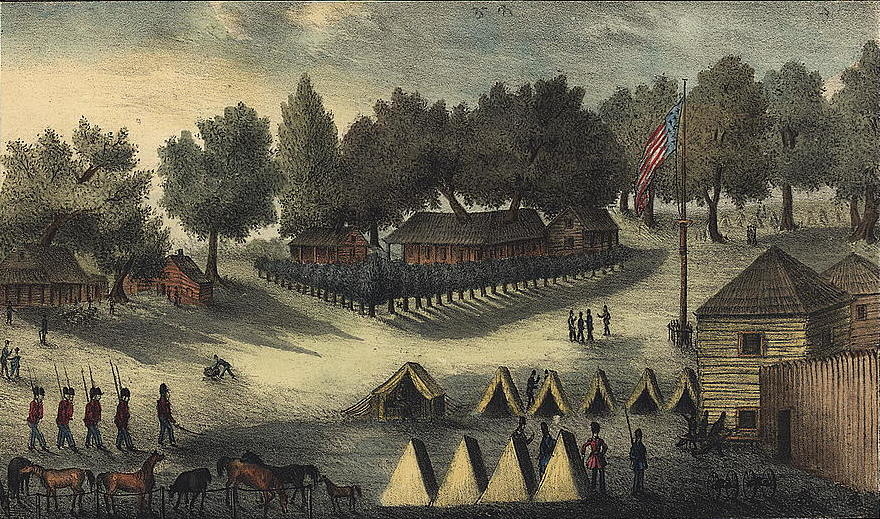|
Dade Massacre
The Dade battle (often called the Dade massacre) was an 1835 military defeat for the United States Army. Under the Indian Removal Act of 1830 the U.S. was attempting to force the Seminoles to move away from their land in Florida provided by the Treaty of Moultrie Creek (following the American annexation of Spanish Florida see the Adams-Onis Treaty) and relocate to Indian Territory under the terms of the Treaty of Payne's Landing. Two U.S. Army companies numbering 103 men under the command of Major Francis L. Dade were ambushed by approximately 180 Seminole and Black Seminole warriors as they marched from Fort Brooke on Tampa Bay to reinforce Fort King in Ocala. Only three U.S. soldiers and their guide Louis Pacheco survived the attack, and one died of his wounds the following day. The battle sparked the Second Seminole War, which ended in 1842. By that time, most Seminoles had surrendered and been transported out of Florida, and a small group remained in central Flori ... [...More Info...] [...Related Items...] OR: [Wikipedia] [Google] [Baidu] |
Louis Pacheco
Louis (Luis) Fatio Pacheco (December 26, 1800 – ?) was an Afro-Spanish enslaved person who became known in 19th century Spanish Florida for his connection to the Black Seminole community. Biography Early life and career Pacheco was born December 26, 1800, in New Switzerland on the plantation of Francis Philip Fatio Sr.—an associate and possibly a partner in Panton, Leslie, & Company. Pacheco's father Adam was a skilled slave working a lot with his hands as a carpenter, building boats, and driver. He was also noted to be a "very intelligent and ambitious man." With Pacheco's father working as a sought-after slave, Pacheco received certain privileges that enabled him to learn how to read and write. This is where he developed his skill for learning multiple languages, and by the time he reached adulthood, he was proficient in French, Spanish, and English. Pacheco also learned the Seminole language from his brother, who was kidnapped by the Indians but later returned to the ... [...More Info...] [...Related Items...] OR: [Wikipedia] [Google] [Baidu] |
Second Seminole War
The Second Seminole War, also known as the Florida War, was a conflict from 1835 to 1842 in Florida between the United States and groups of people collectively known as Seminoles, consisting of Muscogee, Creek and Black Seminoles as well as other allied tribes (see below). It was part of a series of conflicts called the Seminole Wars. The Second Seminole War, often referred to as ''the'' Seminole War, is regarded as "the longest and most costly of the American Indian Wars, Indian conflicts of the United States". After the Treaty of Payne's Landing in 1832 that called for the Seminoles' removal from Florida, tensions rose until fierce hostilities occurred in Dade battle, Dade's massacre in 1835. This engagement officially started the war although there were a series of incidents leading up to the Dade battle. The Seminoles and the U.S. forces engaged in mostly small engagements for more than six years. By 1842, only a few hundred native peoples remained in Florida. Although no pea ... [...More Info...] [...Related Items...] OR: [Wikipedia] [Google] [Baidu] |
Adams–Onís Treaty
The Adams–Onís Treaty () of 1819, also known as the Transcontinental Treaty, the Spanish Cession, the Florida Purchase Treaty, or the Florida Treaty,Weeks, p. 168. was a treaty between the United States and Spain in 1819 that ceded Florida to the U.S. and defined the boundary between the U.S. and Mexico (New Spain). It settled a standing border dispute between the two countries and was considered a triumph of American diplomacy. It came during the successful Spanish American wars of independence against Spain. Florida had become a burden to Spain, which could not afford to send settlers or staff garrisons, so Madrid decided to cede the territory to the United States in exchange for settling the boundary dispute along the Sabine River in Spanish Texas. The treaty established the boundary of U.S. territory and claims through the Rocky Mountains and west to the Pacific Ocean, in exchange for Washington paying residents' claims against the Spanish government up to a total of $5 ... [...More Info...] [...Related Items...] OR: [Wikipedia] [Google] [Baidu] |
Seminole Wars
The Seminole Wars (also known as the Florida Wars) were a series of three military conflicts between the United States and the Seminoles that took place in Florida between about 1816 and 1858. The Seminoles are a Native American nation which coalesced in northern Florida during the early 1700s, when the territory was still a Spanish colonial possession. Tensions grew between the Seminoles and American settlers in the newly independent United States in the early 1800s, mainly because enslaved people regularly fled from Georgia into Spanish Florida, prompting slaveowners to conduct slave raids across the border. A series of cross-border skirmishes escalated into the First Seminole War, when American general Andrew Jackson led an incursion into the territory over Spanish objections. Jackson's forces destroyed several Seminole, Mikasuki and Black Seminole towns, as well as captured Fort San Marcos and briefly occupied Pensacola before withdrawing in 1818. The U.S. and Spain soon ... [...More Info...] [...Related Items...] OR: [Wikipedia] [Google] [Baidu] |
Billy Bowlegs
Holata Micco (a Muscogee name translated as Alligator Chief, also spelled ''Halpatter-Micco'', ''Halbutta Micco'', ''Halpuda Mikko''; known in English as Chief Billy Bowlegs or Billy Bolek; – 1859) was a leader of the Seminoles in Florida during the Second Seminole War and was the remaining Seminole's most prominent chief during the Third Seminole War, when he led the Seminoles' last major resistance against the United States government. With the possibilities of military victory dwindling, he finally agreed to relocate with his people to Indian Territory (present-day Oklahoma) in 1858. As part of the settlement, he was paid $6,500 plus $1,000 each for the subchiefs and $100 each for the women and children who went with him. Several sources claim that he is buried at the Fort Gibson National Cemetery, but it is disputed whether the grave marked "Captain Billy Bowlegs" is actually his or that of a different Billy Bowlegs. Early life and Seminole Wars Bowlegs was born into a f ... [...More Info...] [...Related Items...] OR: [Wikipedia] [Google] [Baidu] |
Abiaka
Abiaka, also known as Sam Jones, (c. 1781 – c. 1866) was a Seminole-Miccosukee chief, warrior, and shaman who fought against the United States during the Seminole Wars. He was born among the Miccosukee people of Georgia, who would migrate south into Florida and become part of the Seminole tribe. He initially rose to prominence among the Seminoles as a powerful shaman. Abiaka became the principal chief of the Seminoles in 1837 during the Seminole Wars. He was a guerrilla warfare tactician and he led the Seminoles at the Battle of Lake Okeechobee, the largest battle of the conflict. Abiaka successfully resisted the United States and its policy of Indian Removal, and his leadership resulted in the continued presence of the Seminole people in Florida. Name The phonetic spelling of his native name varies to include: Aripeka, Aripeika, Opoica, Arpeika, Abiaka, Apiaka,Read, 1934 Apeiaka, Appiaca, Appiacca, Apayaka Hadjo (Crazy Rattlesnake), and Ar-pi-uck-i. The name is derivative of t ... [...More Info...] [...Related Items...] OR: [Wikipedia] [Google] [Baidu] |
Big Cypress National Preserve
Big Cypress National Preserve is a United States National Preserve located in South Florida, about 45 miles (72 kilometers) west of Miami on the Atlantic coastal plain. The Big Cypress, along with Big Thicket National Preserve in Texas, became the first national preserves in the United States National Park System when they were established on October 11, 1974. In 2008, Florida film producer Elam Stoltzfus featured the preserve in a PBS documentary. Big Cypress borders the wet freshwater marl prairies of Everglades National Park to the south, and other state and federally protected cypress country in the west, with water from the Big Cypress flowing south and west into the coastal Ten Thousand Islands region of Everglades National Park. History Archaeology at Platt Island in the preserve shows humans settled there more than two thousand years ago. The Calusa people had an extensive presence in the area when Europeans arrived. Big Cypress was historically occupied by va ... [...More Info...] [...Related Items...] OR: [Wikipedia] [Google] [Baidu] |
Everglades
The Everglades is a natural region of flooded grasslands in the southern portion of the U.S. state of Florida, comprising the southern half of a large drainage basin within the Neotropical realm. The system begins near Orlando with the Kissimmee River, which discharges into the vast but shallow Lake Okeechobee. Water leaving the lake in the wet season forms a slow-moving river wide and over long, flowing southward across a limestone shelf to Florida Bay at the southern end of the state. The Everglades experiences a wide range of weather patterns, from frequent flooding in the wet season to drought in the dry season. Throughout the 20th century, the Everglades suffered significant loss of habitat and environmental degradation. Human habitation in the southern portion of the Florida peninsula dates to 15,000 years ago. Before European colonization, the region was dominated by the native Calusa and Tequesta tribes. With Spanish colonization, both tribes declined g ... [...More Info...] [...Related Items...] OR: [Wikipedia] [Google] [Baidu] |
Ocala, Florida
Ocala ( ) is a city in and the county seat of Marion County, Florida, United States. Located in North Central Florida, the city's population was 63,591 as of the 2020 United States census, 2020 census, up from 56,315 at the 2010 census and making it the List of municipalities in Florida, 43rd-most populated city in Florida. Ocala is the principal city of the Ocala Metropolitan statistical area, metropolitan area, which had a population of 375,908 in 2020. Home to over 400 thoroughbred farms and training centers, Ocala is considered the "Horse Capital of the World". Notable attractions include the Ocala National Forest, Silver Springs State Park, Rainbow Springs State Park, the College of Central Florida, and the World Equestrian Center. History Ocala is named after Ocale (also Cale, Etocale, and other variants), a Timucua village and chiefdom recorded in the 16th century, the name of which is believed to mean "Big Hammock" in the Timucua language. Another possible meaning of t ... [...More Info...] [...Related Items...] OR: [Wikipedia] [Google] [Baidu] |
Fort King
Fort King (also known as Camp King or Cantonment King) was a United States military fort in north central Florida, near what later developed as the city of Ocala. It was named after U.S. Army Colonel William King, commander of the 4th Infantry Regiment and the first American governor of the provisional West Florida region. The fort was built by the U.S. Military in 1827 during tensions with the Seminole in Florida, a tribe of mostly Creek people who formed in the early nineteenth century. The fort was established originally to serve as a buffer between new settlers and the Seminole. It became an important base in the 1830s for the United States Army during the removal of the Seminole and the Seminole Wars. It later served as a courthouse in 1844 after the organization of Marion County, but was abandoned altogether, eventually. The residents took it apart in order to salvage building materials. The site of the fort is preserved as a National Historic Landmark near the corner of Ea ... [...More Info...] [...Related Items...] OR: [Wikipedia] [Google] [Baidu] |
Tampa Bay
Tampa Bay is a large natural harbor and shallow estuary connected to the Gulf of Mexico on the west-central coast of Florida, comprising Hillsborough Bay, McKay Bay, Old Tampa Bay, Middle Tampa Bay, and Lower Tampa Bay. The largest freshwater inflow into the bay is the Hillsborough River, which flows into Hillsborough Bay in downtown Tampa. Many other smaller rivers and streams also flow into Tampa Bay, resulting in a large watershed area. The shores of Tampa Bay were home to the Weeden Island Culture and then the Safety Harbor culture for thousands of years. These cultures relied heavily on Tampa Bay for food, and the waters were rich enough that they were one of the few Native American cultures that did not have to farm. The Tocobaga was likely the dominant chiefdom in the area when Spanish explorers arrived in the early 1500s, but there were likely smaller chiefdoms on the eastern side of the bay which were not well documented. The indigenous population had been decimat ... [...More Info...] [...Related Items...] OR: [Wikipedia] [Google] [Baidu] |
Fort Brooke
Fort Brooke was a historical military post established at the mouth of the Hillsborough River (Florida), Hillsborough River in present-day Tampa, Florida in 1824. Its original purpose was to serve as a check on and trading post for the native Seminoles who had been confined to an interior reservation by the Treaty of Moultrie Creek (1823), and it served as a military headquarters and port during the Second Seminole War (1835–1842). The village of Tampa developed just north of the fort during this period, and the area was the site of a minor raid and skirmish during the American Civil War. The obsolete outpost was sparsely garrisoned after the war, and it was decommissioned in 1883 just before Tampa began a period of rapid growth, opening the land for development. Fort Brooke was located on what is now the southern end of downtown Tampa along eastern bank of the river and the Garrison Channel. Most of the fort's structures were situated at the current site of the Tampa Conventi ... [...More Info...] [...Related Items...] OR: [Wikipedia] [Google] [Baidu] |










